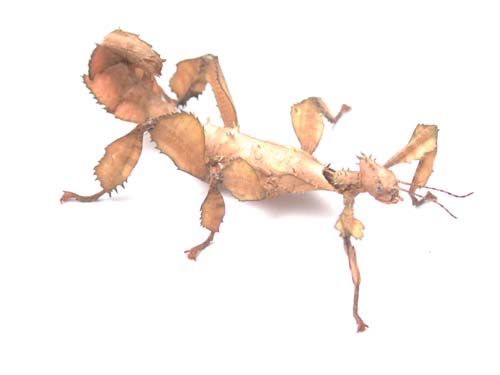
Order
The order Phasmida includes walkingsticks and leaf insects.
Defining features of Phasmids:
1. Phasmid bodies are elongated and slender to resemble sticks, grass,
and (in a few species) leaves (cryptic camoflage).
2. All North American phasmids are wingless except one southern Florida
species, Aplopus mayeri Caudell.
3. Phasmids have mandibulate, prognathous mouthparts.
4. Phasmids do NOT have enlarged hind legs (do not jump).
5. Antennae of Phasmids are long and multisegmented--filiform.
6. All species of phasmid have compound eyes, some flying species have
ocelli.
Taxonomy
The order Phasmida is included in the Orthopteroid superorder which
includes orthoptera (grasshoppers), mantodea (mantids), and blattodea (cockroaches).
There are some 3000 described species of phasmids of which 30 are found
in North America.
Six families make up the order Phasmida:
Timemidae--timemid sticks
Pseudophasmatidae--striped
sticks
Heteronemiidae--common sticks
Phasmatidae--winged sticks
Phylliidae--leaf and tooth-bearing
sticks
Bacillidae--??
Natural History
Phasmids are nocturnal, herbiverous insects found in most temperate
to tropical climates. They are excellent examples of organisms that
utilize crypsis, a form of camoflage wherein the insect mimics its surroundings,
in this case plant matter. Not only do phamids look like sticks and/or
leaves in body shape, their camoflage extends to their movement.
When phasmids walk, they do so slowly while swaying back and forth, matching
the movement of sticks in the wind. This is called juttering.
Some species emit a noxious chemical from their thoraces as a further deterrent
to predators. In yet another means of avoiding predation, these insects
may shed limbs, an option for phasmids since they, unlike most other insects,
are able to regenerate lost limbs over a period of time.
Reproduction
Phasmids have two means of reproduction: sexual reproduction and parthenogenic
birth. In sexual reproduction, the male mounts the female for copulation
which may be very prolonged.
In parthenogenic birth, the female produces viable eggs without being
inseminated by a male. There are a number of phasmid species that
exhibit only parthenogenic birth and have few or no males. Eggs are
either fixed to the surface of leaves, dropped to the ground, or buried.
Anywhere from 100 to 2000 eggs are produced, often resembling seeds for
additional protection.
Phasmid Study Group
Borror, Donald; Charles Triplehorn, Norman Johnson. An Introduction to the Study of Insects. Harcourt College Publishers; Orlando, FL; 1992.
Daly, Howell; John Doyen, Alexander Purcell.Ý Introduction to Insect Biology and Diversity.Ý Oxford University Press; Oxford, UK; 1998.